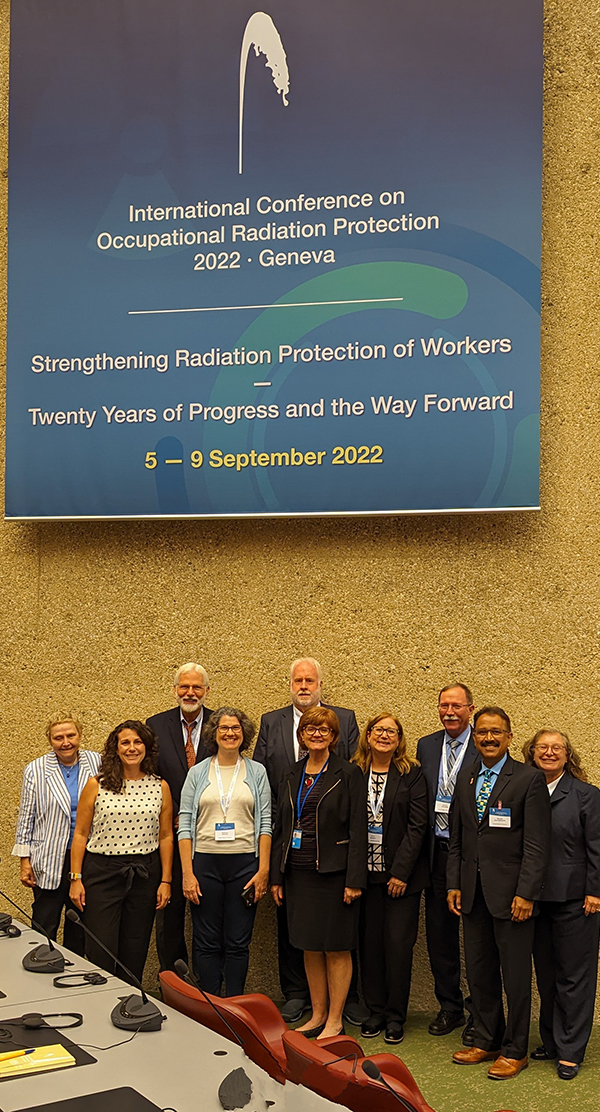News Archive
Dave Allard and Debbie Gilley
As a follow-up to similar conferences in 2002 and 2014, the International Atomic Energy Agency (IAEA) and International Labour Organization (ILO) recently organized the 3rd International Conference on Occupational Radiation Protection, with the theme "Strengthening Radiation Protection of Workers – Twenty Years of Progress and the Way Forward." The meeting was hosted by the Government of Switzerland and held in Geneva 5–9 September 2022. It brought together some 700 radiation protection experts from 105 countries. Objectives of the conference included exchange of information and experience, review of challenges, technical and regulatory advances, review of the global situation on radiation protection of workers, identification of priority actions and future needs, and formulation of conclusions and recommendations.
There were invited presentations to open the sessions, as well as numerous others covering the following topics:
- Review of international standards and recommendations on occupational radiation protection.
- Progress over the past 20 years and existing challenges.
- Radiation effects and health risks from radiation exposure at the workplace.
- Monitoring and dose assessment of occupational radiation exposures.
- Occupational radiation protection in medicine.
- Occupational radiation protection in the workplaces involving exposure to naturally occurring radioactive material (NORM), radon, and cosmic rays.
- Occupational radiation protection in industrial, research, and educational facilities; nuclear power plants; and nuclear fuel cycle facilities.
- Radiation protection in emergency exposure situations and subsequent transition periods.
- Radiation protection of workers in special cases (itinerant workers, apprentices, female workers).
- Optimization in occupational radiation protection.
- Technical service providers in occupational radiation protection.
- Education and training in occupational radiation protection.
- Probability of causation of occupational harm attributable to radiation exposure, health surveillance, and compensation.
- Management systems, radiation protection networks.
- Occupational exposure levels and dose registries.
- Safety culture in occupational radiation protection.
A summary of the meeting presentations and conclusions is being prepared for publication by the IAEA. However, the themes of the sessions are noted below.
The increasing use of ionizing radiation in medical procedures has resulted in an increase in the number of occupationally exposed workers over the years, with certain interventional fluoroscopy procedures being a continuing challenge.
There is a need to protect workers in industries involving NORM and to apply a graded approach by regulators and facility operators. Continued NORM experience exchange is needed to establish the balance for radiation protection and other safety aspects. Regulation and control of radon exposure in workplaces remains an important topic.
Nuclear power plants (NPPs) used in Member States may grow to meet the rapid increase in carbon-free energy demand. Countries are building new NPPs with new reactor designs, giving rise to some challenges for occupational radiation protection. NPPs that come to the end of their operating life, and are in need of decommissioning, will affect the radiation protection of workers.
Experience and feedback from the implementation of the IAEA's Basic Safety Standards will be important for international harmonization and future revision of radiation protection standards. In particular, the reduction of the dose limit for the lens of the eye has presented practical challenges in implementation. Dave Allard presented on the significant disconnect between radiation protection regulations and basic standards in the United States. There was consensus on efforts to develop safety culture in radiation protection that should continue in order to prevent incidents/accidents.
For additional details see the meeting page on the IAEA website and the IAEA article "Tailored Approaches Key to Optimizing Occupational Radiation Protection."
 The US delegation of presenters and attendees included, left to right:
The US delegation of presenters and attendees included, left to right:
Melissa Martin (Therapy Physics/American Association of Physicists in Medicine, attendee)
Dori Willis (US Nuclear Regulatory Commission, presenter)
Dave Allard (Conference of Radiation Control Program Directors, past chair, presenter)
Cathy Ribaudo (National Institutes of Health, presenter)
Rusty Lorenzen (Boston Children's Hospital, poster presenter)
Debbie Gilley (Conference of Radiation Control Program Directors, past chair, presenter)
Donna Newman (International Society of Radiographers and Radiological Technologists, presenter)
Vince Holahan (US Nuclear Regulatory Commission, presenter)
Mahadevappa Mahesh (Johns Hopkins University/American Association of Physicists in Medicine, presenter)
Kathy Modes (US Nuclear Regulatory Commission, presenter)
Submitted photo




